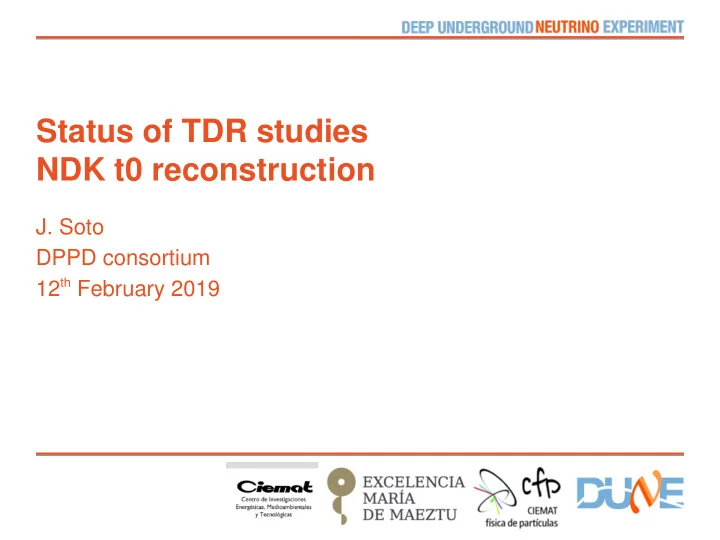

Status of TDR studies NDK t0 reconstruction J. Soto DPPD consortium 12 th February 2019
Content • Previous status of the analysis. • Including MCTruth position. • Background reduction. • Matching process. • Results. 2 J. Soto | TDR studies, t0 reconstruction
Previous status (CM201901) • We don't reach the 90% of t0 matching efficiency in all volume. • BUT this study was considering just the detected light over the background (without considering additional information provided by the trigger). • Next steps → To consider the MCTruth position in the PMT plane. 3 J. Soto | TDR studies, t0 reconstruction
RecoCluster vs MCTruth Position • If we consider the center of the maximum reconstructed cluster as the reconstructed position, we can compare with the montecarlo truth position (expected to be provided by the trigger). • We observe a smearing of ~5m.
RecoCluster vs MCTruth Position • Looking at the distance in the PMT plane, most of the events are reconstructed within a radius of 5m around the MCTruth vertex. This distance distribution is wider as we go up in the drift direction. • If we reduce our area of interest to this circle of 5m radius around the trigger point, we can reduce our background.
Background reduction *Full 4seconds sample • The background level is not uniform along the YZ plane. • Since we have the YZ position of the event, we should get only the background events in the vicinity. • We can define a distance, and take into account only the background events of the same intensity (#PEs) of the signal cluster.
Matching process • Since we don't have the mixed sample yet (signal+background), I compute the matching N=1 probability rather than efficiency Matching probability = 0 • Matching process: – I take the number of background clusters in the vicinity, N, with similar intensity to the signal cluster (>0.8 #PEs) in a 16ms N=0 Matching probability = 1 window. – Vicinity is defined as a circle of radius D, and center the MCTruth position. – If the reconstructed cluster of the signal is inside the vicinity, the probability to be well N=1 Matching probability = 0.5 matched is 1/(1+N) – If not, Probability = 0. BG cluster • I define the Matching efficiency as the average Signal Cluster of the probability to be well matched. Arrow marks the MCTruth vertex.
Matching efficiency • A scan in the Matching Distance (D) parameter has been perform, to find the balance between background rejection and signal detection. • Red curve shows the matching efficiency. • Black curve shows the matching efficiency with no background, converging with the efficiency for small distances. • Green curve shows the background contribution to the matching efficiency, assuming that the signal cluster is always in the vicinity of the MCTruth position. • We have a maximum around 0.78 in D~5m (this plot considers 16ms of background).
Matching efficiency scan in drift direction • We are able to match the 80% of the events, with the right cluster. • We reach up to 8meters of the TPC AV above 90% efficiency. • (Considering matching distance of 5m, and 8ms of background per event). 9 J. Soto | TDR studies, t0 reconstruction
A possible improvement: • Introducing a dependency of D with the #PEs: #PE < exp(13.15-d/60.8) 10 J. Soto | TDR studies, t0 reconstruction
Recommend
More recommend